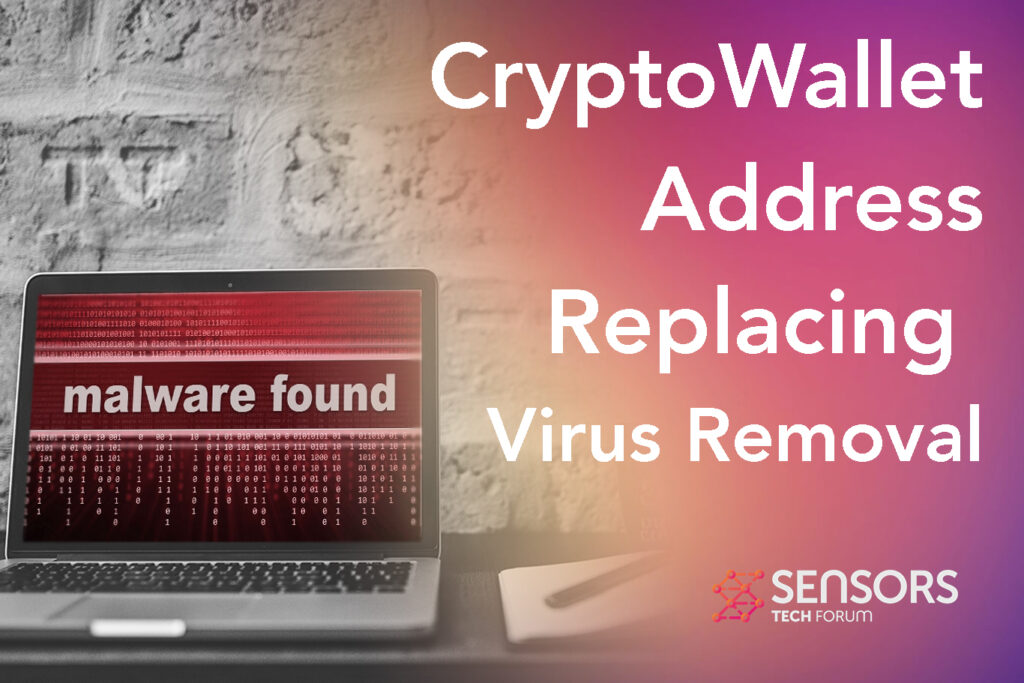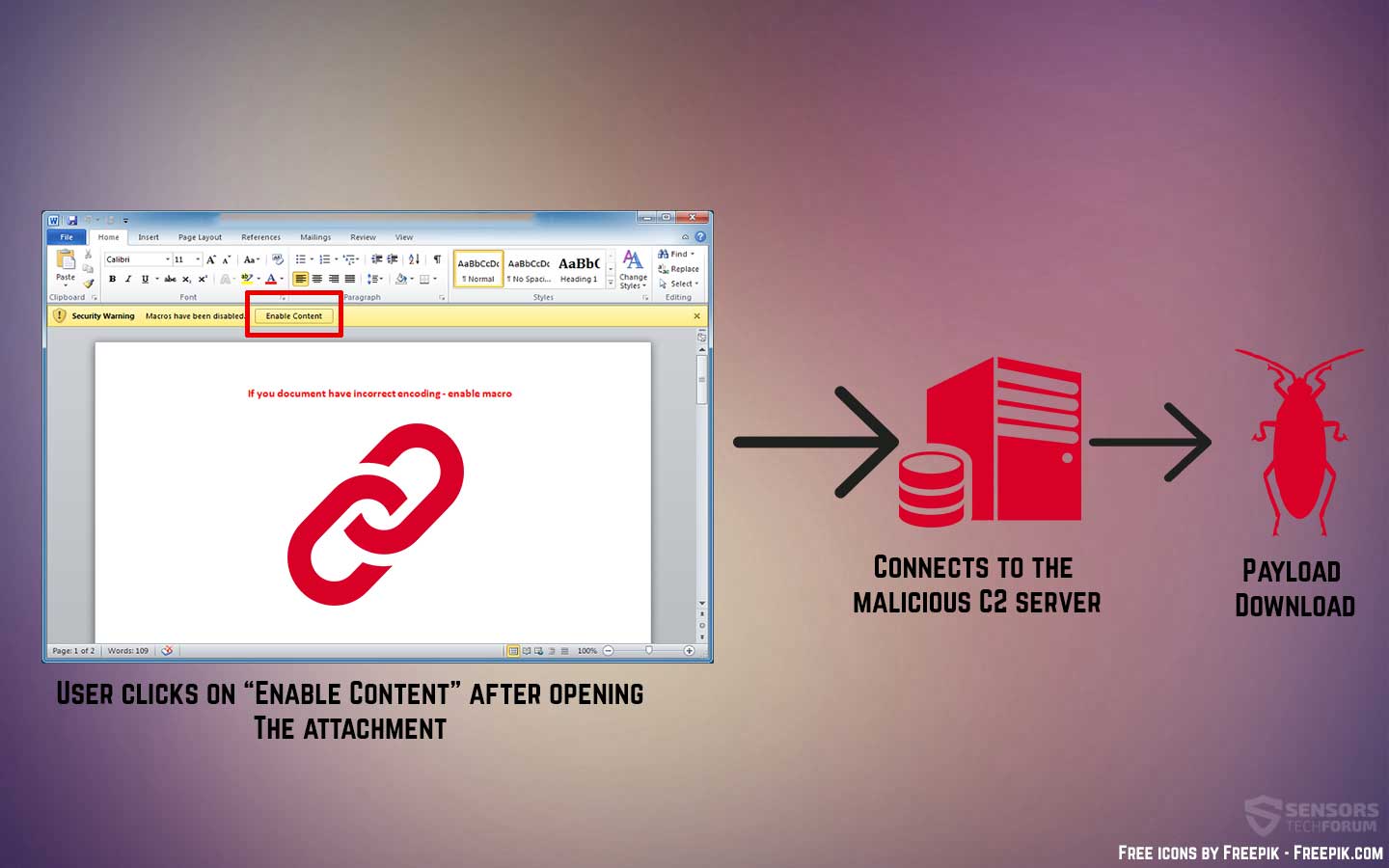What is CryptoWallet Address Replacing Virus?
CryptoWallet Address Replacing virus just the name for the type of malware that can be used to steal your cryptocurrency funds. This very tricky virus may perform series of malicious activities, the main ones of which are focused in staying hidden on your computer right up till the moment you send crypto funds to another wallet. This particular virus may replace what do you have copied with a crypto wallet of the criminals that are behind it and you may send them funds instead of the actual target you meant the transfer to be in the first place.
Read this article to learn more about how you can you protect your cryptocurrency funds from such a virus and how to remove one if you believe that your system has been compromised by it.

CryptoWallet Address Replacing Virus Summary
| Name | CryptoWallet Address Replacing Virus |
| Type | Trojan Horse / Clipper virus |
| Brief Description | Aims to perform dangerous crypto fund stealing actions and spyware activities as well. |
| Symptoms | Your computer could become very slow and even freeze from time to time. Your clipboard may be modified. |
| Distribution Technique | From suspicious sites or as an e-mail attachment. |
| Detection Tool |
See if the System is impacted by CryptoWallet
Down Load
Malware Removal Tool
|
User Experience | Join Our Forum to go over CryptoWallet. |
CryptoWallet Address Replacing Virus Trojan – How Did I Get It?
CryptoWallet Address Replacing virus is essentially clipping malware and may function just like any other virus with spyware characteristics out there, for example the recently detected Bloom.exe, SharkBot and Trojan.Win32.PDF.Alien.gen ones.
This program may have ended up on your device via multiple different methods, one of which is if it got sent to you as a result of an email, carrying it as an attachment, that pretends to be a legitimate and important document. Once this document is downloaded and executed, it may trigger the following infection procedure:
CryptoWallet Address Replacing Virus – What Does It Do?
Once CryptoWallet Address Replacing virus past infected your computer, it may assume rights as administrator over it. This happens by dropping its malicious files on your drive, which may be located in the following directories of Windows under different names:
- %Local%
- %AppData%
- %Temp%
- %Windows%
The virus will modify the Run and RunOnce registry system keys of Windows as well, which allows it to run automatically each time you turn on your computer systemL
HKEY_LOCAL_MACHINE\Software\Microsoft\Windows\CurrentVersion\Run
HKEY_LOCAL_MACHINE\Software\Microsoft\Windows\CurrentVersion\RunOnce
HKEY_CURRENT_USER\Software\Microsoft\Windows\CurrentVersion\Run
HKEY_CURRENT_USER\Software\Microsoft\Windows\CurrentVersion\RunOnce
But the main purpose of this malware is to track what you copy on your computer system. Each phrase or password that you may copy may trigger it to steal the information from you and may even result in you having your passwords exposed. It may even go as far as to replace what you have initially copied with the address of the criminals, resulting in sending them crypto instead of the original address.
CryptoWallet Address Replacing Virus – How Dangerous Is It?
CryptoWallet Address Replacing Virus it’s not only dangerous to your crypto, but it may act as any other threat of the spyware kind and perform the following malicious activities as well:
- Download other viruses.
- Update its miners, control them.
- Take screenshots.
- >Steal files.
- Log the keystrokes you type.
- Obtain data from your PC.
- Control your microphone and audio.
This is why it is imperative to secure your computer system against this threat and others like it immediately.

Remove CryptoWallet Address Replacing Virus from Your Computer
In order to clear your computer system from this virus and any other Mallard that may have compromised as a result of infections, our main suggestion is following the instructions beneath. If you want the best possible removal and future protection against these viruses, the best way to go for is using a professional anti-malware software. Experts often recommend using this program in particular, because it has the capability of thoroughly checking any viruses and getting them completely rid of your computer, plus ensuring protection in the future as well.
Preparation before removing CryptoWallet.
Before starting the actual removal process, we recommend that you do the following preparation steps.
- Make sure you have these instructions always open and in front of your eyes.
- Do a backup of all of your files, even if they could be damaged. You should back up your data with a cloud backup solution and insure your files against any type of loss, even from the most severe threats.
- Be patient as this could take a while.
- Scan for Malware
- Fix Registries
- Remove Virus Files
Step 1: Scan for CryptoWallet with SpyHunter Anti-Malware Tool



Step 2: Clean any registries, created by CryptoWallet on your computer.
The usually targeted registries of Windows machines are the following:
- HKEY_LOCAL_MACHINE\Software\Microsoft\Windows\CurrentVersion\Run
- HKEY_CURRENT_USER\Software\Microsoft\Windows\CurrentVersion\Run
- HKEY_LOCAL_MACHINE\Software\Microsoft\Windows\CurrentVersion\RunOnce
- HKEY_CURRENT_USER\Software\Microsoft\Windows\CurrentVersion\RunOnce
You can access them by opening the Windows registry editor and deleting any values, created by CryptoWallet there. This can happen by following the steps underneath:


 Tip: To find a virus-created value, you can right-click on it and click "Modify" to see which file it is set to run. If this is the virus file location, remove the value.
Tip: To find a virus-created value, you can right-click on it and click "Modify" to see which file it is set to run. If this is the virus file location, remove the value.Step 3: Find virus files created by CryptoWallet on your PC.
1.For Windows 8, 8.1 and 10.
For Newer Windows Operating Systems
1: On your keyboard press + R and write explorer.exe in the Run text box and then click on the Ok button.

2: Click on your PC from the quick access bar. This is usually an icon with a monitor and its name is either “My Computer”, “My PC” or “This PC” or whatever you have named it.

3: Navigate to the search box in the top-right of your PC's screen and type “fileextension:” and after which type the file extension. If you are looking for malicious executables, an example may be "fileextension:exe". After doing that, leave a space and type the file name you believe the malware has created. Here is how it may appear if your file has been found:

N.B. We recommend to wait for the green loading bar in the navigation box to fill up in case the PC is looking for the file and hasn't found it yet.
2.For Windows XP, Vista, and 7.
For Older Windows Operating Systems
In older Windows OS's the conventional approach should be the effective one:
1: Click on the Start Menu icon (usually on your bottom-left) and then choose the Search preference.

2: After the search window appears, choose More Advanced Options from the search assistant box. Another way is by clicking on All Files and Folders.

3: After that type the name of the file you are looking for and click on the Search button. This might take some time after which results will appear. If you have found the malicious file, you may copy or open its location by right-clicking on it.
Now you should be able to discover any file on Windows as long as it is on your hard drive and is not concealed via special software.
CryptoWallet FAQ
What Does CryptoWallet Trojan Do?
The CryptoWallet Trojan is a malicious computer program designed to disrupt, damage, or gain unauthorized access to a computer system. It can be used to steal sensitive data, gain control over a system, or launch other malicious activities.
Can Trojans Steal Passwords?
Yes, Trojans, like CryptoWallet, can steal passwords. These malicious programs are designed to gain access to a user's computer, spy on victims and steal sensitive information such as banking details and passwords.
Can CryptoWallet Trojan Hide Itself?
Yes, it can. A Trojan can use various techniques to mask itself, including rootkits, encryption, and obfuscation, to hide from security scanners and evade detection.
Can a Trojan be Removed by Factory Reset?
Yes, a Trojan can be removed by factory resetting your device. This is because it will restore the device to its original state, eliminating any malicious software that may have been installed. Bear in mind that there are more sophisticated Trojans that leave backdoors and reinfect even after a factory reset.
Can CryptoWallet Trojan Infect WiFi?
Yes, it is possible for a Trojan to infect WiFi networks. When a user connects to the infected network, the Trojan can spread to other connected devices and can access sensitive information on the network.
Can Trojans Be Deleted?
Yes, Trojans can be deleted. This is typically done by running a powerful anti-virus or anti-malware program that is designed to detect and remove malicious files. In some cases, manual deletion of the Trojan may also be necessary.
Can Trojans Steal Files?
Yes, Trojans can steal files if they are installed on a computer. This is done by allowing the malware author or user to gain access to the computer and then steal the files stored on it.
Which Anti-Malware Can Remove Trojans?
Anti-malware programs such as SpyHunter are capable of scanning for and removing Trojans from your computer. It is important to keep your anti-malware up to date and regularly scan your system for any malicious software.
Can Trojans Infect USB?
Yes, Trojans can infect USB devices. USB Trojans typically spread through malicious files downloaded from the internet or shared via email, allowing the hacker to gain access to a user's confidential data.
About the CryptoWallet Research
The content we publish on SensorsTechForum.com, this CryptoWallet how-to removal guide included, is the outcome of extensive research, hard work and our team’s devotion to help you remove the specific trojan problem.
How did we conduct the research on CryptoWallet?
Please note that our research is based on an independent investigation. We are in contact with independent security researchers, thanks to which we receive daily updates on the latest malware definitions, including the various types of trojans (backdoor, downloader, infostealer, ransom, etc.)
Furthermore, the research behind the CryptoWallet threat is backed with VirusTotal.
To better understand the threat posed by trojans, please refer to the following articles which provide knowledgeable details.















